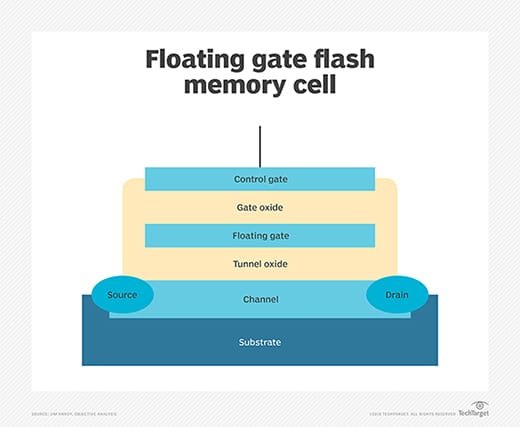NVRAM (non-volatile random access memory) refers to computer memory that can hold data even when power to the memory chips has been turned off.
NVRAM is a subset of the larger category of non-volatile memory, which includes storage-class memory based on NAND flash. Flash memory chips are slower to read to and write from than RAM chips, making them less suited for active computational memory.
Computer manufacturers mainly use NVRAM to hold information about the state of the computer for faster boot times. This enables information about the components and devices in the computer to be stored from one use to the next while the system power is turned off. Standard computer memory uses dynamic RAM (DRAM), which requires constant power to retain data.
Static random access memory (SRAM) is the predecessor to DRAM and is much faster to read from. It enables byte-level data reads, whereas DRAM requires page-level reads, consisting of multiple bytes at a time. SRAM cannot hold data without an electrical charge, however, so it becomes non-volatile by using a battery to keep a constant trickle charge. SRAM is considerably more expensive to manufacture than DRAM, making it best suited for small data storage applications such as storing computer startup data -- BIOS data on Windows PCs and parameter RAM data on Apple computers.
Electrically erasable programmable read-only memory (EEPROM) is based on the floating gate transistor, which uses a highly insulating material for the gate terminal, or switch, that turns a transistor from a binary 1 or 0 digit. Unless a high enough voltage is applied to open the gate, the transistor stays in the last state it held, and the overall chip holds on to the data those binary digits make up.

Both SRAM and EEPROM chips require much higher power to operate than DRAM, increasing wear and reducing their useful life.
Ferroelectric RAM (FRAM) is designed similar to DRAM. However, instead of a dielectric layer, FRAM uses a thin ferroelectric material layer that changes polarity when an electric current is applied. When the current is shut off, the layer retains that last polarity and the chip holds the data. Because the storage density is much lower than in DRAM and the material is much more durable under harsh conditions, FRAM is typically found in specific industrial and automotive applications.
Magnetoresistive RAM (MRAM) uses the alteration of magnetic states in a magnetoresistive material instead of electrical states in a dielectric material to store the binary 1 or 0 bits that make up stored data. The data is read and written using a reading and writing technology called spin transfer torque, which enables greater storage density for MRAM over DRAM. Unlike flash memory, MRAM doesn't degrade with constant use.
Phase change memory (PCM) is based on the ability to change the physical state of a material from a liquidlike amorphous solid to a crystalline solid and back again, much like a CD or DVD. With PCM, the material changes state when electric current, not laser light, is applied. The material can be made to change state rapidly, making PCM even faster in read and write times than NAND flash, theoretically approaching the speed of DRAM.
Like EEPROM chips, NAND flash is based on floating gate transistors. However, it has been designed with a lower cost of manufacturing in mind, so the internal structure is different than EEPROM. Data is stored in blocks, instead of the pages of DRAM or the bytes of SRAM. This makes the internal wiring structure of NAND flash memory simpler than other types of memory and enables greater storage density, driving down the overall cost per byte stored. It also makes flash memory slower than other types of chip-based memory but faster than magnetic disk-based memory, such as hard disk drives.
NVRAM and flash memory come together in a product called a non-volatile dual in-line memory module (NVDIMM), which is designed to fit in the DIMM slots on a computer's motherboard.
The NVDIMM-F variety uses all-flash memory in a form factor that fits into a DIMM socket. However, it needs to be paired with a DRAM DIMM module designed to work with the NVDIMM-F module. NVDIMM-N makes standard DRAM non-volatile by adding flash memory to the module itself.
Because the motherboard's BIOS doesn't recognize flash memory as usable for active computational memory, NVDIMMs require updating the BIOS on most computers.
Technically, an NVDIMM of either flavor isn't NVRAM because it isn't RAM at all (NVDIMM-F) or is volatile DRAM with non-volatile flash memory.
Editor's note: This article was revised in 2024 by TechTarget editors to improve the reader experience.